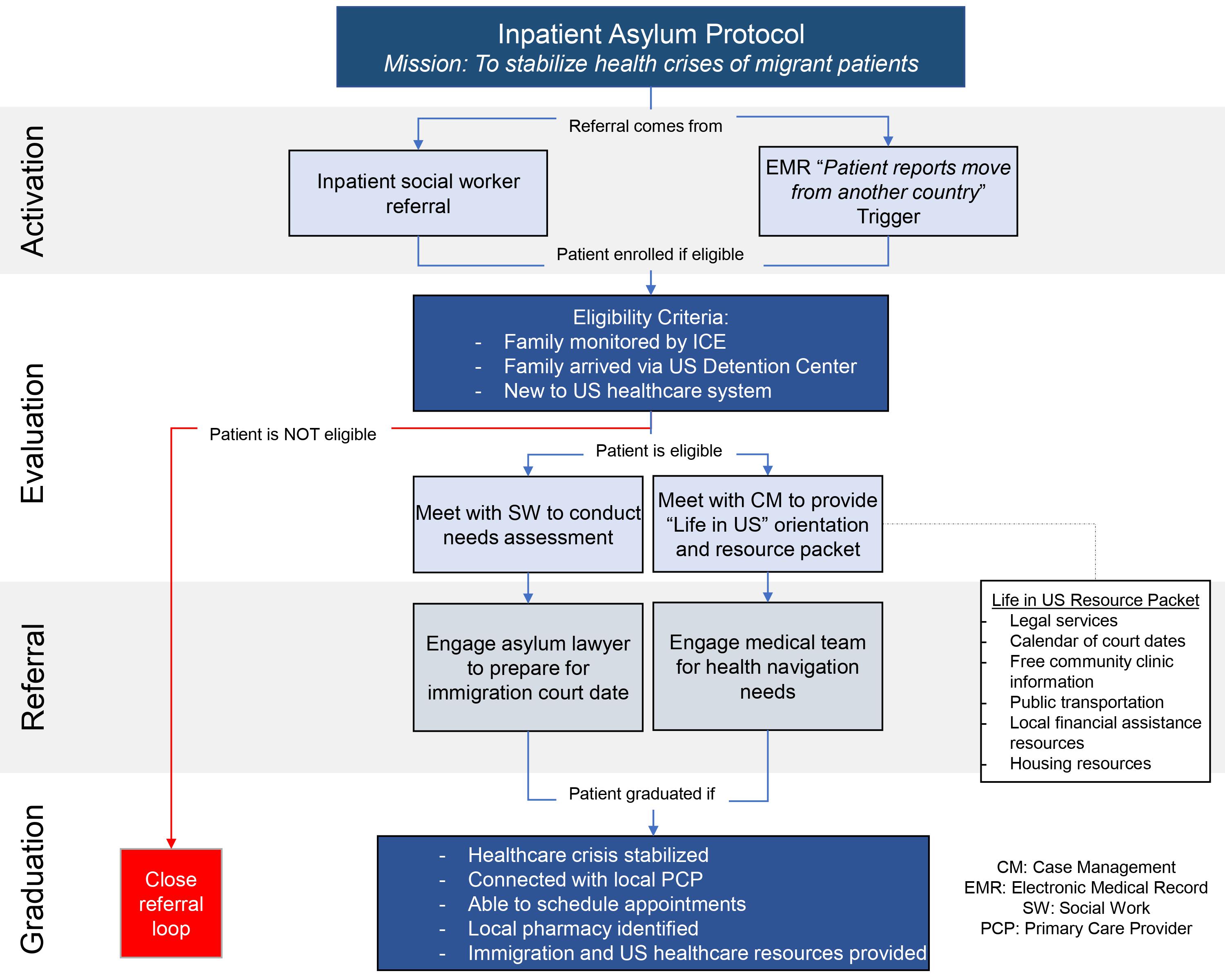Back
Health Equity/Social Determinants of Health
Category: Abstract Submission
Health Equity/Social Determinants of Health VI
181 - An inpatient protocol for families seeking asylum: One children’s hospital's experience
Monday, April 25, 2022
3:30 PM – 6:00 PM US MT
Poster Number: 181
Publication Number: 181.413
Publication Number: 181.413
Melanie Ramirez, Stanford University School of Medicine, Stanford, CA, United States; Daniela Rey Ardila, Lucile Packard Children's Hospital Stanford, Santa Clara, CA, United States; Lisa J. Chamberlain, Stanford University School of Medicine, Stanford, CA, United States; Victoria Ward, Stanford University School of Medicine, Stanford, CA, United States

Melanie Ramirez
Program Manager
Stanford University School of Medicine
Stanford, California, United States
Presenting Author(s)
Background: Children with complex medical needs face unique challenges, which are compounded when their families are also seeking asylum. Asylum seekers often present to healthcare systems with complicated social history: past experiences of trauma, need for legal services, and difficulty accessing public benefits due to fear or ineligibility.
Objective: To address the complex needs of asylum-seekers, a transdisciplinary team developed and implemented an inpatient protocol to identify, screen, and support asylum-seeking patients and families in a children’s hospital.
Design/Methods: A transdisciplinary team including physicians, nurses, social workers, case managers, and asylum-seeking families, built the Inpatient Asylum Protocol (IAP) to improve the hospital’s capacity to: (1) identify families claiming asylum, (2) obtain sensitive social histories, (3) orient asylum-seekers to the U.S. healthcare system, and (4) coordinate medical, legal, and social services. A retrospective chart review was performed to describe the patient population: demographic data, service line at admission, and primary diagnoses were extracted. Utilization of legal services and protocol graduation rates (defined by stabilization of medical crisis and completed orientation to the U.S. healthcare system), were collected from case management records to assess protocol impact.
Results: The IAP was activated 71 times between July 2019 – November 2022 for pediatric and obstetric patients, with thirty-nine referrals eligible for IAP medical and social support services (49% male, age 7 days - 38 years). Protocol activation came from social work (49%) or the medical care team (51%). The majority of referrals were made from General Pediatrics (38%), followed by the Pediatric Intensive Care Unit (15%). The most common ICD10 diagnosis codes indicated infectious disease (31%) followed by gastrointestinal disease (13%). Asylum-seekers arrived from Guatemala (46%), Mexico (26%), El Salvador (18%), Honduras (5%), and Nicaragua (5%). Twenty of the 39 patients were graduated from the protocol and 27 (69%) received referrals to legal services.Conclusion(s): The IAP identified asylum-seeking families admitted to a children’s hospital and improved access to multidisciplinary services. An important next step includes assessing the protocol’s impact by evaluating the satisfaction and clinical outcomes of patients served by the IAP. The IAP serves as a starting point for children’s hospitals to better address the complex needs and barriers to care for asylum-seeking patients.
Figure 1. Inpatient Asylum Protocol Workflow
Table 1. Characteristics of Patients Enrolled in the Inpatient Asylum Protocol (IAP) (n=39).jpg) *Data represents more diagnoses than IAP patients as some had more than one significant diagnosis
*Data represents more diagnoses than IAP patients as some had more than one significant diagnosis
Objective: To address the complex needs of asylum-seekers, a transdisciplinary team developed and implemented an inpatient protocol to identify, screen, and support asylum-seeking patients and families in a children’s hospital.
Design/Methods: A transdisciplinary team including physicians, nurses, social workers, case managers, and asylum-seeking families, built the Inpatient Asylum Protocol (IAP) to improve the hospital’s capacity to: (1) identify families claiming asylum, (2) obtain sensitive social histories, (3) orient asylum-seekers to the U.S. healthcare system, and (4) coordinate medical, legal, and social services. A retrospective chart review was performed to describe the patient population: demographic data, service line at admission, and primary diagnoses were extracted. Utilization of legal services and protocol graduation rates (defined by stabilization of medical crisis and completed orientation to the U.S. healthcare system), were collected from case management records to assess protocol impact.
Results: The IAP was activated 71 times between July 2019 – November 2022 for pediatric and obstetric patients, with thirty-nine referrals eligible for IAP medical and social support services (49% male, age 7 days - 38 years). Protocol activation came from social work (49%) or the medical care team (51%). The majority of referrals were made from General Pediatrics (38%), followed by the Pediatric Intensive Care Unit (15%). The most common ICD10 diagnosis codes indicated infectious disease (31%) followed by gastrointestinal disease (13%). Asylum-seekers arrived from Guatemala (46%), Mexico (26%), El Salvador (18%), Honduras (5%), and Nicaragua (5%). Twenty of the 39 patients were graduated from the protocol and 27 (69%) received referrals to legal services.Conclusion(s): The IAP identified asylum-seeking families admitted to a children’s hospital and improved access to multidisciplinary services. An important next step includes assessing the protocol’s impact by evaluating the satisfaction and clinical outcomes of patients served by the IAP. The IAP serves as a starting point for children’s hospitals to better address the complex needs and barriers to care for asylum-seeking patients.
Figure 1. Inpatient Asylum Protocol Workflow

Table 1. Characteristics of Patients Enrolled in the Inpatient Asylum Protocol (IAP) (n=39)
.jpg) *Data represents more diagnoses than IAP patients as some had more than one significant diagnosis
*Data represents more diagnoses than IAP patients as some had more than one significant diagnosis